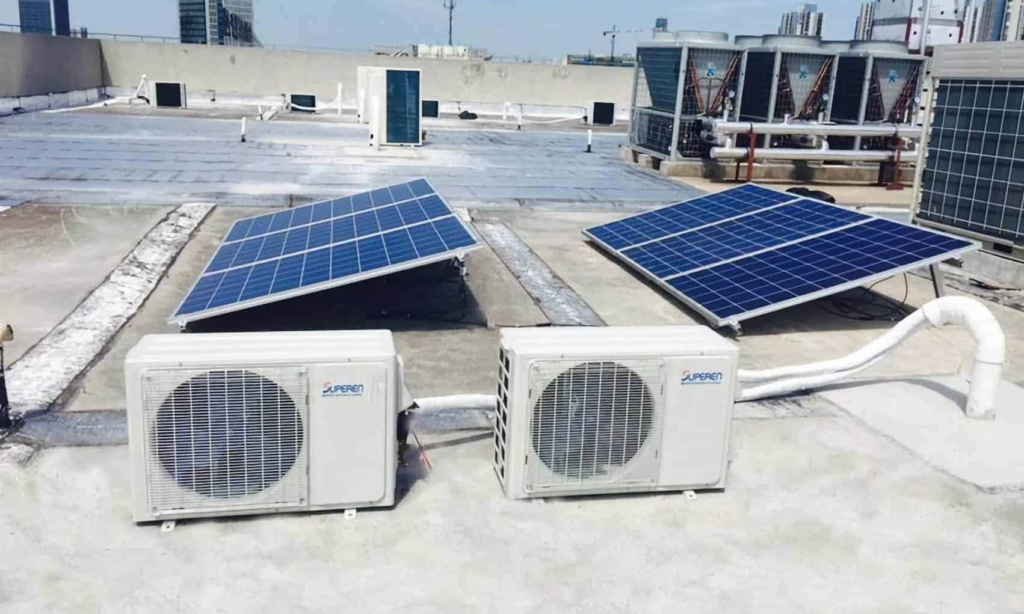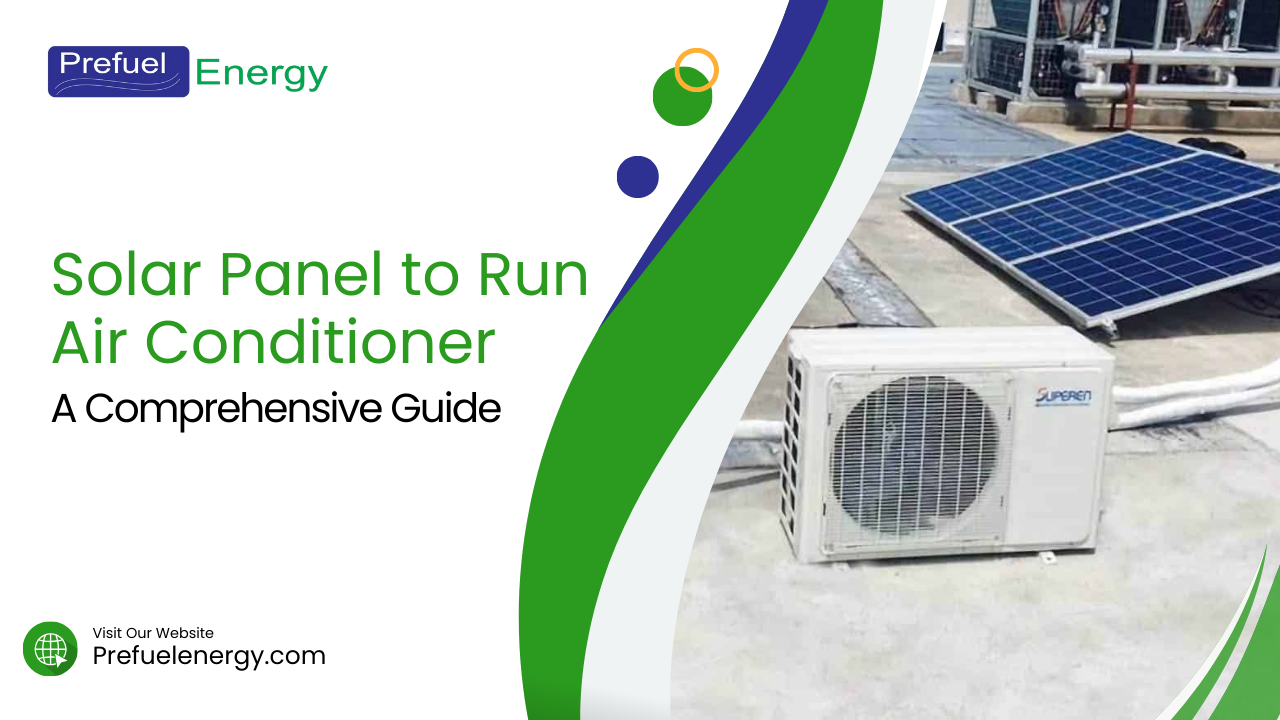In our modern world, air conditioning has become a necessity, especially in regions with hot and humid climates. However, the increasing demand for energy has led to rising electricity costs and environmental concerns. Fortunately, solar energy offers a sustainable and cost-effective solution to power your air conditioning system. In this informative article, we’ll explore the world of solar panel to run air conditioner efficiently
Table of Contents
Understanding Solar Panels and Air Conditioners

Before we dive into the specifics of running an air conditioner on solar power, let’s first understand the basics of both technologies.
Solar Panels
Solar panels are devices that convert sunlight into electrical energy. They are typically made up of photovoltaic cells that absorb sunlight and generate direct current (DC) electricity. This DC electricity is then converted into alternating current (AC) using an inverter, which can be used to power various household appliances.
Air Conditioners
Air conditioners are devices that regulate the temperature and humidity of indoor spaces. They work by absorbing heat from the air inside a room and transferring it outside, effectively cooling the space. Air conditioners come in various sizes, measured in tons, with 1 ton being equivalent to 12,000 BTU/h (British Thermal Units per hour).
Factors to Consider When Solar Panel to Run Air Conditioner
When Solar Panels to Run Air Conditioners, there are several factors to keep in mind:
- Air Conditioner Size: The size of the air conditioner is crucial in determining the amount of solar power required. As a general rule, a 1.5-ton air conditioner requires approximately 2,000 watts of solar power to run efficiently.
- Solar Panel Efficiency: The efficiency of the solar panels used will determine how much electricity they can generate from the available sunlight. More efficient panels will require less space and fewer panels to generate the required power.
- Battery Storage: Since air conditioners require a significant amount of power, it’s essential to have a reliable battery storage system to store excess energy generated during the day for use at night or during periods of low sunlight.
- Inverter Capacity: The inverter used to convert DC to AC electricity must be sized appropriately to handle the power requirements of the air conditioner.
- Shading: Shading can significantly reduce the efficiency of solar panels. It’s essential to ensure that the panels are installed in an area with minimal shading throughout the day.
Calculating Solar Panel Requirements for Your AC
To determine the number of solar panel to run air conditioner, you’ll need to consider the following factors:
AC Unit Power Consumption
The first step is to determine the power consumption of your air conditioner. This information can typically be found on the unit’s label or in the manufacturer’s specifications. The power consumption is usually expressed in watts or British Thermal Units (BTUs).
Solar Panel Output
Solar panels have varying output capacities, which are measured in watts or kilowatts. The output of a solar panel depends on factors such as its size, efficiency, and the amount of sunlight it receives.

Sunlight Availability
The amount of sunlight available in your area plays a crucial role in determining the number of solar panels required. Regions with higher solar irradiance require fewer panels to generate the same amount of energy compared to areas with lower solar irradiance.
Peak Sun Hours
Peak sun hours refer to the number of hours per day when the sun’s intensity is strong enough to generate maximum output from the solar panels. This factor varies depending on your location and the time of year.
Example – Calculating the Solar Power Required for a 1.5-Ton Air Conditioner
To illustrate the calculation process, let’s consider a scenario where you have a 1.5-ton (18,000 BTU) air conditioner with an energy efficiency ratio (EER) of 12. Assuming you live in an area with an average of 5 peak sun hours per day, and you want to use solar panels with an output of 300 watts each, here’s how you can calculate the number of panels required:
AC power consumption = (18,000 BTU / 12 EER) / 1,000 = 1.5 kW
Solar panel output required = 1.5 kW / 5 peak sun hours = 0.3 kW
Number of solar panels required = 0.3 kW / 0.3 kW per panel = 1 panel
In this example, you would need one 300-watt solar panel to run a 1.5-ton air conditioner during peak sun hours. However, it’s important to note that this is a simplified calculation, and factors such as panel efficiency, temperature, and shading can affect the actual output.
Installing Solar Panel to Run Air Conditioner
Installing solar panel to run air conditioner requires the expertise of a professional solar installer. They will assess your power requirements, design a suitable system, and handle the installation process. It’s essential to choose a licensed and experienced installer to ensure the safety and efficiency of your solar system.
Solar Panel Installation and Connection to AC
Once you’ve determined the number of solar panels required, the next step is to install them properly and connect them to your air conditioning system.
Site Selection and Panel Orientation
Choosing the right location and orientation for your solar panels is crucial for maximizing their output. Generally, solar panels should be installed in an area with minimal shading and oriented towards the south (in the northern hemisphere) or north (in the southern hemisphere) to receive maximum sunlight exposure.
Racking and Mounting Systems
Solar panels need to be securely mounted on a racking system, which can be installed on rooftops, ground-mounted, or integrated into building structures. The racking system should be designed to withstand local wind and weather conditions.
Inverters and Battery Storage
Solar panels generate direct current (DC) electricity, which needs to be converted to alternating current (AC) to power your air conditioning unit. This conversion is done by an inverter. Additionally, if you want to use solar power when the sun isn’t shining, you’ll need to install a battery storage system.
Wiring and Electrical Connections
Proper wiring and electrical connections are essential for safely connecting your solar panel system to your air conditioner. It’s recommended to hire a qualified solar installer or electrician to ensure the installation meets local building codes and safety standards.
Maintenance and Monitoring
Regular maintenance and monitoring of your solar panel system are crucial for ensuring optimal performance. This includes cleaning the panels, checking for shading or obstructions, and monitoring the system’s output and performance.
Apply Now For Solar Panel to Run Air Conditioner
Cost and Financing Options for Solar-Powered AC Systems
Installing a Solar Panel to Run Air Conditioner system can be a significant investment, but it can also provide long-term cost savings and environmental benefits.
Upfront Costs
The upfront costs of a solar-powered AC system include the cost of solar panels, inverters, batteries (if needed), installation, and any necessary electrical work. These costs can vary depending on the size of the system, location, and local labor rates.
Long-term Cost Savings
While the initial investment may be higher, solar-powered AC systems can provide significant long-term cost savings by reducing or eliminating your electricity bills for air conditioning. Additionally, many governments and utilities offer incentives and rebates for installing solar systems, which can further offset the upfront costs.
Financing Options
To make solar-powered AC systems more accessible, various financing options are available, such as:
- Solar loans: Specialized loans designed for financing solar installations.
- Leasing programs: Leasing solar panels from a provider, with the option to purchase the system later.
- Power purchase agreements (PPAs): Agreements where a third-party owns and maintains the solar system, and you pay for the electricity generated.
Payback Period and Return on Investment
The payback period and return on investment for a solar-powered AC system depend on factors such as the system’s cost, electricity rates in your area, and available incentives. Many homeowners and businesses can expect to recoup their initial investment within 5 to 10 years and enjoy substantial long-term savings.

Benefits of Running an Air Conditioner on Solar Power
Running an air conditioner on solar power offers several benefits:
- Cost Savings: While the initial investment in solar panels may be high, the long-term savings on electricity bills can be significant.
- Environmental Benefits: Solar power is a clean and renewable energy source, reducing your carbon footprint and contributing to a more sustainable future.
- Reliability: With proper battery storage, a solar-powered air conditioning system can provide reliable cooling even during power outages.
- Increased Property Value: Installing a solar-powered air conditioning system can increase the value of your property.
Conclusion
Running an air conditioner on solar power is a viable and sustainable option for homeowners in India. By considering the factors mentioned in this guide and working with a professional solar installer, you can enjoy the benefits of clean, reliable, and cost-effective cooling for your home.
FAQ of Running an Air Conditioner on Solar Power
The short answer is yes, air conditioners can run on solar power. However, the feasibility of this setup depends on several factors, such as the size of the air conditioner, the available solar radiation, and the efficiency of the solar panels.
To run a 1.5-ton air conditioner, you will need approximately 2,000 watts of solar power, which typically requires 6-8 solar panels, depending on the panel size and efficiency.
Yes, a 1.5-ton air conditioner can run on solar power, provided you have a sufficient number of solar panels and a reliable battery storage system.
The cost of running a 1.5-ton air conditioner on solar power varies depending on several factors, such as the cost of solar panels, batteries, inverters, and installation. However, the long-term savings on electricity bills can offset the initial investment.
Yes, running an air conditioner on solar power is possible in India, given the country’s abundant sunlight and the increasing affordability of solar technology.
The time it takes to recoup the investment in a solar-powered air conditioning system depends on various factors, such as the cost of electricity in your area, the size of your system, and the amount of sunlight available. However, with the increasing cost of electricity and the decreasing cost of solar technology, the payback period is becoming shorter.


